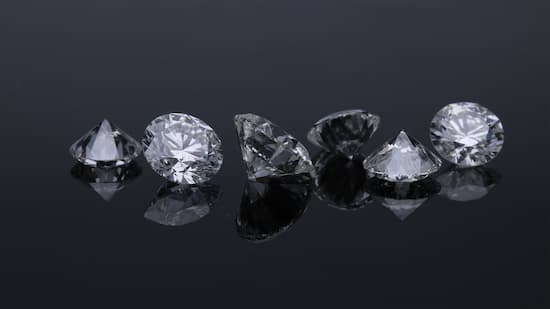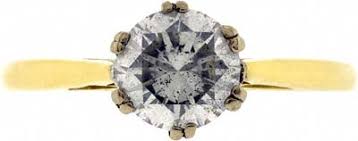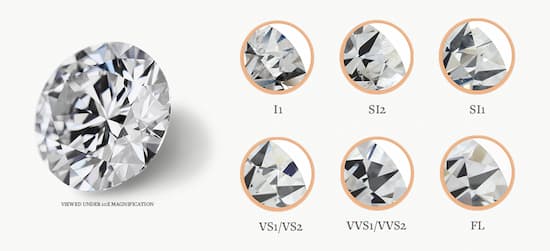Opposed to other imitation gemstones, the value of a diamond does not degrade over time. On that note, even diamonds are imperfect. One noticeable flaw are the hazy effects with cloudy diamonds and other blemishes are barely seen. These cloudy effects sometimes are a problem, but not all the time. This is why there are cloudy diamonds for sale. Let us take a closer look at what all these hazy diamonds are. Familiarize yourself with how to differentiate between a good and a bad one of these types.

“Clouds” in a lab certificate are one inclusion type that can sometimes be a problem for diamond shoppers. The gemological term “cloud” refers to a group of very minute inclusions in diamonds. They can be taken in many forms, different sizes and densities. Under any magnification, they are easily sighted but sometimes, they are also almost transparent. The mere fact that “cloud” is part of a diamond report does not necessarily imply that the diamond will be cloudy, or that there is any appreciable loss of diamond transparency.
Diamond looks white not clear because of fluorescence even though it can also improve its color. Be very keen, in particular, for diamonds with “very strong” fluorescence belonging in D-I color grades while being on the watch for medium fluorescence belonging in D-G color grades. More often than not, it is on these levels where it causes a hazy look and milky diamond looks dull.

Furthermore, it is imperative for the consumers to know that haziness is not visible under the circumstances of store lights. It helps to view the diamond in broad daylight if you are canvassing them in person. However, if you are buying online, it would be best to steer clear of these fluorescence combinations. Additionally, here’s a pro tip from us: only take a look at fluorescent diamonds from reputable sellers. This guarantees high quality and removes all doubts you might have. When personally shopping for a diamond, always check on these diamonds under UV lights.
GIA or AGS lab certifications usually do not have a clarity plot for diamonds having less than 1 carat. As you may know, a clarity plot is a reference to a list of certain imperfections of a diamond. Without this reference, it would be difficult to know how big a cloud in a diamond can be or the fact where it is located. If you want to review its clarity then you will have to look at the diamond yourself.

Moreover, be sure to pay keen attention to SI1 clarity grade diamonds or even lower grades. If it states in a report that there is a “clarity grade based on clouds that aren't shown”, be able to discern that there is a huge possibility of large clouds present and covering parts of the diamond. This needs a lot of attention. Furthermore, such cases indicated that there may be several smaller, tiny clouds that can warrant the lower clarity grade. However, when combined they create what is now a hazy diamond.
Finally, but not least, external factors can actually cause a cloudy diamond engagement ring. It is true that a diamond’s intrinsic qualities can be the root cause of a milky or hazy look. However, neglected external cleanliness can just be as much to blame. Many people fail to realize that their diamond engagement rings are just losing their sparkle because they fail to perform their regular cleaning maintenance. Take note that any jewelry piece is susceptible to dirt, grime, and oils that make our diamond looks dull. With that said, try getting your diamond ring cleaned first the next time it starts getting cloudier.
No, these milky, hazy diamonds are not always bad. It will actually depend on how severe the “cloudy” effect is on your diamond. Your cloudy diamond engagement ring can still be a very attractive, beautiful stone with its cloudiness that is only minimal and not taking a large portion of the entire stone. Additionally, a very small count of these milky looks on the edges won’t be a bother to your diamond’s quality. They can hardly be noticed and sometimes, they are just covered by the ring setting. However, larger clouds are your red flag. They influence the diamonds' transparency and beauty.
Yes, cloudy diamonds still have their worth. However, they are usually lower compared to the prices of non-cloudy diamonds. For obvious reasons, non-cloudy diamonds are more clear and brilliant in stone. Hence, they are more attractive and alluring to the eyes of consumers. Should you consider buying a cloudy diamond, best to get those of the lowest clarity grade that are still top-quality diamonds. This will then save you hundreds of dollars. But then again, don't forget to always consider a reputable store to buy these precious stones. Given that real diamonds are more expensive than cloudy ones, you may wonder: are diamonds rare?
The intrinsic qualities of a cloudy diamond engagement ring can hardly be fixed. This encompasses inclusions that make your ring look cloudy. However, if your diamond is having that milky look due to external factors such as residue and grimness, then it can always be cleaned. Having your stone regularly cleaned will showcase its brilliance, particularly when light hits the diamond.
So, you would rather avoid buying a cloudy diamond. This can be fixed. Go for brilliant stones instead. It is without a doubt that the quality of the diamond generally influences its beauty. Going for an eye-clean and a very clear, transparent-looking yet sparkly stone is the best diamond that is free from any cloudiness. Anything less of this is a lesser quality of a diamond. These are the stones having many inclusions that you clearly want to avoid.
Your diamond looks cloudy under UV light because of diamond fluorescence. It is the glow you get when a certain object, in this case 一 the diamond, emits light. When a diamond is exposed to UV light, its fluorescence shows, making it look cloudy. With that said, not all diamonds fluoresce.
One good and workable method to clear up a cloudy diamond is to regularly have its cleaning maintenance. On top of this, it will keep your ring shiny and looking new. You can go for a makeshift cleaning by simply washing your engagement ring with water and soap using a soft-bristle brush. Of course, you can always bring your jewelry piece to a local jeweller and get it cleaned there, bringing back your diamond’s sheen.
The Claddagh ring meaning is to show your loved ones that you appreciate them. The ring itself literary signifies love, friendship, and loyalty.
Read MoreIt is not a simple task to tell the difference between brass vs gold if you are not familiar with precious metals at all. Don’t worry. While both metals are precious, we will help you uncover in this read how to tell one from the other. Let us take a closer look at understanding these two metals.
Read MoreBrass jewelry is popularly used in furniture because of its elegant shine. However, can they be a good choice for jewelry? Today, I’ll provide you the answer.
Read MoreBracelets are a piece of jewelry fondly worn by many because of bracelet meanings. This makes bracelets more sentimental. Find out more of these bracelet definitions in this quick read.
Read More